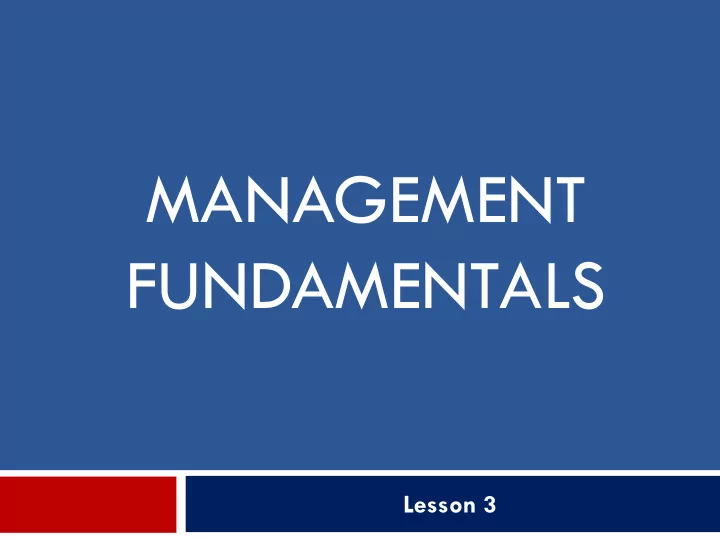

MANAGEMENT FUNDAMENTALS Lesson 3
Strategic and Operational Planning Chapter 07
Plan is the blue print which drives a company confidently towards the unforeseen future…
What is Planning? Planning is the process of setting organisation’s goals and deciding how best to achieve them 1 – goal setting 2 – defining strategy, tactics and action plans to achieve the set goals
SHORT TERM PLANNING vs. LONG TERM PLANNING Short term plans are becoming more favourable and realistic
Levels of Plans/Goals Mission statements outline the stated purpose and values, aspirations and reason for being in business What is the purpose behind we carrying out our business? Mission “Enable people and businesses throughout the world to realize their full potential”
Mission of TOYOTA Mission of Toyota is to provide safe & sound journey
Levels of Goals/Plans and their Importance Strategic Plans : Prepared for the entire organization (defines the holistic approach of the company) Tactical Plans : Prepared for major divisions and departments
Division ABC Company Electronics Pharmaceuticals FMCG Business Marketing Administration HR Finance
Levels of Goals/Plans and their Importance Whole Organization Department Individuals/units Operational Plans: Results expected from departments, work groups and individuals (defines detail action plans)
Benefits of Goals and Plans Legitimacy Source of motivation and commitment Resource allocation Guides to action Rationale for decisions Standards of performance
PLANNING APPROACHES • Usa sage ge based sed approa oach: ch: – Single use plans – Standing plans • Objecti ective e based ed approa oach ch: Management by Objectives (MBO) • Situa uati tion on based sed approa oach ch: Contingency plans 8/18/2018 GDM M 401 PB: HDM
Single and Standing Plans Usage Plans used or Single use referred only plans Plans (Based on once the frequency Plans referred of usage) Standing plans and used repeatedly
Single Use Plans These plans are developed to achieve a set of goals that are not likely to be repeated in the future (for one-time achievements/activities) These plans normally prepared for Programmes and Projects A programme is a complex set of objectives and plans to achieve an important, one-time organisational goal (e.g. A plan prepared to carryout a program to enhance disciplinary behavior of employees) A project is similar to a programme, but generally smaller in scope and complexity (A plan prepared to initiate a CSR project in A’pura )
Standing Plans Standing Plans are on-going plans/documents that provide guidance to tasks which are generally performed and referred repeatedly within an organization These plans include Policies, Rules and Procedures: Policies Accepted/Agreed guidance – e.g. How to select a supplier? Supplier selection policy Rules Accepted norms – e.g. How should employees behave? Code of ethics Procedures Agreed methods or steps to follow – e.g. Procedure to handle employee grievances
Management by Objectives – MBO Method MBO is a system whereby managers and employees define goals for every department, project, and person and use them to monitor subsequent performance. In this method, managers and subordinates sit together and define goals and objectives to be achieved within a given Peter Drucker period of time for which the subordinate is directly held Practice of Management, 1954 responsible Non-MBO Manager Goals / Plans Dialogue Subordinate MBO Goals / Plans Manager Subordinate
Model of the MBO Process
Contingency Plans Contingency plan - plan that determines the alternative course of action to be taken if an intended plan is unexpectedly disrupted or rendered inappropriate Plans for emergencies, setbacks or unexpected conditions These plan would reduce the possible lost to personnel and properties
Disney’s Cruise Line Once Walt Disney announced plans to launch a cruise line with familiar Disney characters and themes, managers also began aggressively developing and marketing packages. The inaugural sailing was sold out more than a year in advance, and the first year was booked solid six months even before the ship was launched. Three months before the first sailing, however, the shipyard constructing Disney’s first ship notified that it was behind schedule and that delivery would be several weeks late. Since Disney had no other ships they had no other options but to refund money to the passengers who booked the first 15 cruises. Big discounts were proposed to those passengers who would rebook on a later cruise. Many of them, however, could not rearrange their schedules and requested full refunds. Some were blaming managers at Disney for poor planning
Past Paper Question - Jan 2010 Organizations vision and mission statements determines the direction of the organization. Briefly define the concept of organization mission and examine how it influences the goal setting and planning in organization 20 marks
The End
Recommend
More recommend